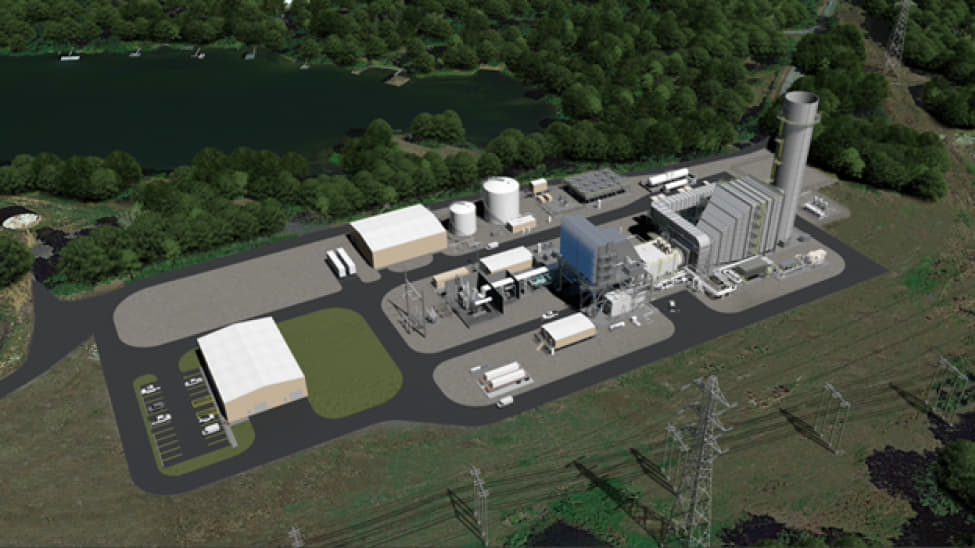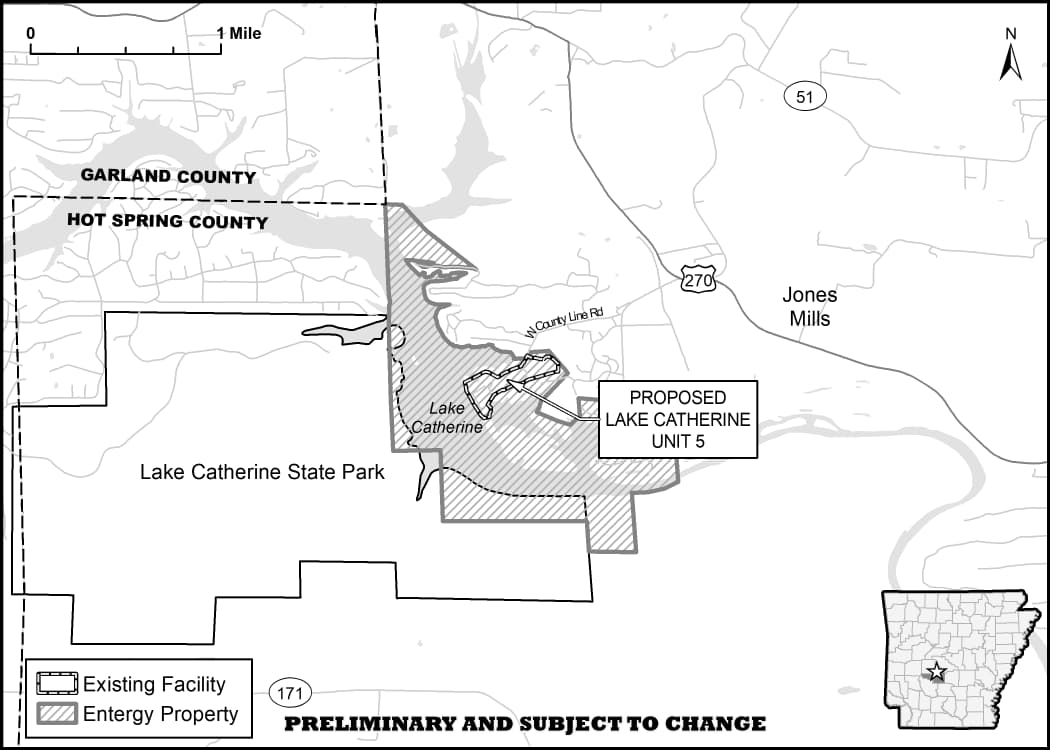Lake Catherine 5
Entergy Arkansas generation resources
Entergy Arkansas is pleased to provide affordable, efficient and reliable power to industrial, commercial, agricultural and residential customers to meet electricity needs today and for years to come. The company operates an “all-of-the-above” portfolio of generating assets: two nuclear generating units (ANO 1 and 2), four coal-fueled generating units (White Bluff 1 and 2, Independence 1 and 2), three hydroelectric plants (Remmel, Carpenter, Blakely) one large natural gas-fueled steam electric generation station (Lake Catherine Unit 4), three combined-cycle gas turbine generating facilities (Union Power Station, Hot Spring, Ouachita), and one solar facility (Searcy Solar). In addition, Entergy Arkansas purchases capacity and associated energy from the Grand Gulf Nuclear Station in Mississippi, has executed two Arkansas Public Service Commission (APSC)-approved PPAs with Stuttgart Solar and Chicot Solar, and has APSC approval to add two new large renewable PPAs (Flat Fork and Forgeview Solar) to its portfolio. Further, Entergy Arkansas will soon own and operate three new large solar facilities (Walnut Bend, West Memphis and Driver Solar).
Several of the company’s legacy generating assets will cease operations (or, for the coal units, cease to burn coal) over the coming decade. The first to cease operations will be Lake Catherine Unit 4 (LC4), a natural gas unit that will shut down at the end of 2027 after more than 50 years of operation on the eastern shore of Lake Catherine.
Entergy Arkansas is proactively planning to replace these generating assets with modern technology that continues to meet the needs of its customers and enables Entergy Arkansas to maintain an “all-of-the-above” generation portfolio. The proposed Lake Catherine Unit 5 (LC5) will fill the need created by the retirement of LC4, bolstering the company’s reliability efforts and supporting anticipated load growth across Entergy Arkansas’ service territory. As proposed, LC5 will create flexibility and optionality for Entergy Arkansas once it begins operations in 2028.
Proposed natural gas generation station
LC5 is a proposed natural gas-fired combustion turbine (CT) unit in a simple cycle configuration that is anticipated to produce 446 megawatts of electricity and will replace the legacy, gas-fired 522-megawatt LC4 facility that entered service in 1970. LC5 will be capable of co-firing 30% hydrogen as fuel, and the unit is designed to potentially enable conversion to hydrogen as an exclusive fuel source. To that end, LC5 has been designed and will be constructed in a way that supports customers’ sustainability goals and Entergy Arkansas’ path toward decarbonization. LC5 will be designed as a flexible resource, capable of rapid starts and load changes in response to system needs. Modern emissions control systems will be installed in the unit, which has a lower emissions profile than LC4 even without hydrogen co-firing.
Economic impact
Lake Catherine 5 is expected to provide somewhere between 230 and 260 jobs during the peak of the construction phase. Entergy Arkansas anticipates sourcing these workers and vendors locally where practicable.
During the operational life of the resource, Entergy Arkansas expects to employ at least nine full-time employees to operate the facility and outside services for project site maintenance like land management and vegetation control, which is expected to have a local impact. Local businesses such as restaurants, stores and hotels could also benefit indirectly from the infusion of construction workers and activity during the construction portion of the project. Entergy Arkansas will also continue to support the local community through the payment of property taxes as well as through financial contributions to local nonprofit organizations as well as Entergy Arkansas employees’ volunteer hours.
Proposed location
Entergy Arkansas anticipates utilizing an approximate 20-acre area of its existing Lake Catherine Power Generation property, located in the Jones Mills area off U.S. Highway 270, to construct the project. The final footprint of the proposed LC5 project is expected to be approximately 10 acres and has been configured to avoid impacts to natural and human resources as well as other obstacles or constraints. This land was previously utilized by the facility for fuel oil storage.
Schedule overview
- First quarter 2024 to fourth quarter 2025: Development activities include resource assessment, environmental studies, interconnection studies, APSC regulatory proceeding and permitting.
- Second quarter 2026 to second quarter 2028: Site construction
- Fourth quarter 2028: Construction complete and operation begins
Project considerations
Entergy Arkansas intends to collaborate and communicate with community members and key leaders throughout this project. All final decisions regarding new facilities will be made only after considering public input. Feedback from our customers, area residents and community leaders is essential in developing an effective and efficient project plan. Entergy Arkansas welcomes any comments that you may have.
Virtual open house
Entergy Arkansas developed this webpage for the public to review the proposed project requirements. Entergy Arkansas anticipates filing for a Certificate of Environmental Compatibility and Public Need (CECPN) with the Arkansas Public Service Commission on or about November 1, 2024. Entergy Arkansas welcomes you to provide any feedback through a comment form found here. Please download and email the completed form to [email protected]. You may also call 501-213-0706 to provide feedback.
Notice to landowners
Several factors must be considered when embarking on a project of this scale, including:
- Construction costs – Construction costs are a major consideration in the design and approval of the project. This project is proposed to utilize property currently owned by Entergy Arkansas. The project area was historically used for storage of fuel oil and will be repurposed to house the infrastructure necessary for LC5. Existing access points and current infrastructure will be used to the extent possible, which will reduce the overall cost of the plant.
- Transmission line and facilities – No additional right-of-way is anticipated for the transmission line interconnection of LC5. The existing LC4 transmission interconnection will be utilized to connect the proposed LC5 unit to the existing Arklahoma Substation located near Jones Mills. Any new transmission line components are anticipated to be confined to Entergy Arkansas-owned properties and facilities.
- Aesthetic considerations and other environmental factors – The proposed LC5 unit will be constructed adjacent to the current LC4 unit and near the Jones Mills Industrial Park. The facility will not alter the current industrial land use. The proposed facility footprint is within an area that has historically been utilized for industrial purposes. Locating the LC5 facility on this site will minimize environmental impacts and limit the amount of tree clearing required.
- Health and safety – Safety is the highest priority for Entergy Arkansas. In accordance with the requirements set forth in the National Electrical Safety Code, the company will construct and operate the proposed electrical facilities at its standard voltage design and will observe reasonable safety precautions to ensure public safety. Construction methods and activities in the field will also meet U.S. Department of Labor Occupational Safety and Health Organization requirements. In addition, Entergy Arkansas maintains and follows its own safety policies and procedures as part of the Entergy Enterprise Safety Standards.
- Regulatory and permitting – Entergy Arkansas anticipates requesting a CECPN for LC5 from the Arkansas Public Service Commission. The Arkansas Department of Energy and Environment – Division of Environmental Quality, as well as other federal and state agencies, requires Entergy Arkansas to file for approval of various permits for construction of the proposed facility. Entergy Arkansas will apply for all necessary certifications and permits for the proposed facility.
Next steps
Construction phase – The proposed facilities will be designed and constructed under the direction and supervision of Entergy Arkansas and consistent with state and federal law. Construction activities will include site soil preparation and installation of foundations, followed by erection/assembly of structural steel, power island equipment and auxiliary equipment/buildings.
Frequently asked questions
Plant operations
What kind of power plant is LC5?
The proposed LC5 is a modern, energy-efficient, natural gas turbine that will operate in simple-cycle mode and will replace the existing Lake Catherine Unit 4 (LC4) facility that came online more than 50 years ago. LC4 will deactivate by December 31, 2027. LC5 will be a significant benefit to Entergy Arkansas’ resource portfolio. It will replace the generation lost by the deactivation of the existing generating facilities and is needed to help ensure that Entergy Arkansas can continue to provide affordable, efficient and reliable service to its customers.
Environmental impact
How will LC5 affect air quality emissions compared to the existing plant?
LC5 is anticipated to result in a reduction in emissions from current operations.
What impact will the changes have on Lake Catherine’s water quality and aquatic life?
Entergy Arkansas will coordinate with the Arkansas Department of Energy and Environment, as well as other public agencies and officials, to minimize any impacts to Lake Catherine.
Public health and safety
What safety measures are in place to protect the surrounding community?
Entergy Arkansas’ top priority is to have a safe, accident-free environment. Safety measures will meet the specific needs of the project, community and impacted areas. In addition, dust suppression activities such as watering roads and construction areas to minimize dust is a standard practice for Entergy Arkansas.
Project timeline
What is the timeline for construction of LC5?
Construction is anticipated to begin in early 2026 and be completed in 2028.
If you have any questions about the project, please email [email protected] or call 501-213-0706 and leave a detailed message.


